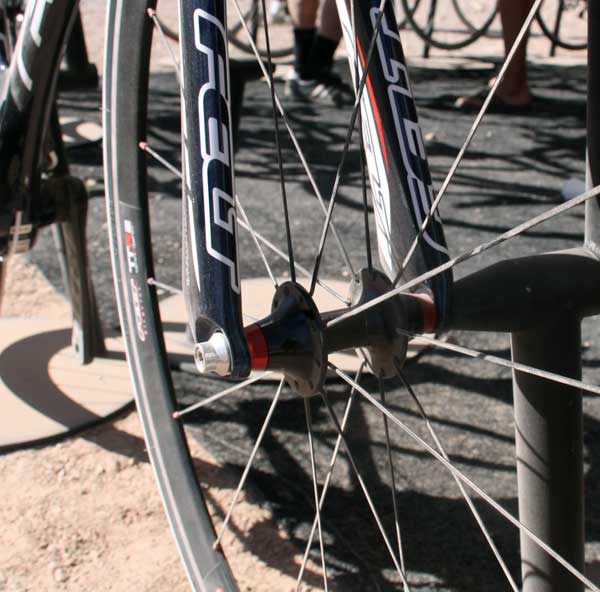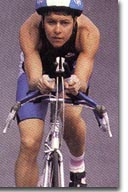The Hooker
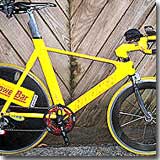
It's considered the aerodynamic benchmark for double-diamond (front and rear triangle) bikes. It's the Hooker Elite, and was built by Gary Hooker about a decade ago.
This is Gary Hooker of Hooker Headers. In 1962 he designed a header for his new 409 Chevrolet, and any baby boomer who played with muscle cars in his youth has heard of, and maybe owned, the exhaust system that generated that deep throaty sound.
Gary Hooker and his partner in the header business Dave Spangler first did the Ironman in 1981, and I met them both over there (it was my Ironman debut as well). Hooker placed the best of us all. He was 12th place overall, with a 3:12 marathon—a pretty good time for today, let alone then.
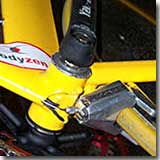
Hooker is still a runner and two years ago ran the part of the Pacific Crest Trail that goes through California. Nowadays he spends most of his training time paddling longboards with another triathlon old-timer, Ron Smith.
Dave Spangler was and continues to be a very good time trial rider, and regularly did and does set national age-group records for 40km. Of the two Spangler was the main force behind getting the bike project up and running. The two had been messing around with bike aerodynamics since about 1984, and were partners with Scott and Vickie Gordon, and Chester Kyle, in Aerosports. Before Steve Hed and all the rest, Aerosports' Scott Gordon was designing the world's best aerodynamic wheels and handlebars. I was introduced to Steve Hed by Vickie Gordon in 1987, and back then there was enough magnanimity in the industry to allow Hed and the Gordons to exhibit in the same trade show booth, even though they made essentially the same products.
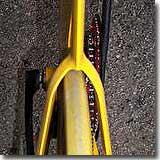
Hooker attempted to make the bike in the same Tijuana factory in which he made his headers. He hired Dave Tesch—a respected frame builder in the '80s—to run his bike factory. Tesch and Hooker made some steel frames for my QR brand back then.
Their idea was for the Hooker Elite was to jump immediately to the head of the pack in technology. No dues paying. No incremental jumps. No working their way up the totem pole. They intended to make bikes in a what they considered the "right way," which was a way in no one else practiced.
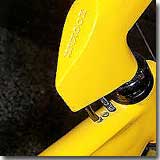
First were the raw materials. They invested in extrusion dies that yielded extremely narrow and long 6061 aluminum tubes. The tube profiles would not be UCI legal today (but they'd be fine in triathlons and regular time trials). They learned everything they could about aerodynamics and applied it all to the Hooker Elite.
The fork was made entirely of steel, but of very thin tubes. It wasn't especially light, but it had a small profile, like the old, cheap forks on Schwinn cruiser bikes made in that company's Ashtabula factory. The old Ashtabula forks were extremely heavy, but to my knowledge have yet to be bested in the wind tunnel except by the now-recalled Hotta forks, and the Lotus fork. Certain of today's forks—perhaps the Cobb-designed Oval, and Reynolds Ouzo Pro Aero—may again start to challenge the numbers generated by these older forks.
Hooker made its own front hubs, and the hub attached into the "dropouts" without a quick release. There was no dropout per se, just a hole into which the axles rested. Hooker also made its own seat post and stem for use in the frame.
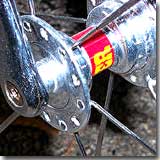
Hooker had found that it was impossible to weld and heat treat his frames and have them remain as straight and true as he wanted. His solution was to machine in the bottom bracket threads and faces, the dropouts, and so forth, and to do that in a finished frame. This was the part of the process that was unprecedented in the industry, and for good reason. It was extremely laborious and time consuming, and required a lot of dedicated fixtures and machinery.
The frame production was therefore never as lean and precise as Hooker and Spangler wanted. They eventually gave up on making the Hooker bikes, mainly because their standards were impossibly high and they couldn't make the bike they wanted for any reasonable amount of money.

A few Hookers remain, and these are the '64 Ford Cobras of the road bike world. As the photos (thanks to Andrew Peabody for letting us use photos of his Hooker) indicate, this bike was very, very lean. From straight on, you could hardly see it. When you look at the trailing edge of the head tube, you can see what my inspiration was when I designed a gusset for the Kilo Private Reserve (though when I consider Davidson's trailing edge in his yet older time trial bikes, it looks like these bikes might've been Hooker's inspiration for his trailing edge).
Still today nobody can do a rear triangle like Hooker did it. All of today's look positively obese compared to the Hooker's seat stays. Likewise, the seat tube and seat mast are skinny like a runway model. But they don't have the rear wheel cutout, probably because Hooker employed a road race geometry which used a longer chainstay length. In this particular area Cervelo has the Hooker bested. Its bikes do a better job of fairing the rear wheel.
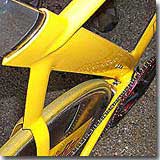
The only bikes I know of that ever compared favorably with the Hooker aerodynamically were the Softrides, the old Zipps, and the Lotus. The Cervelos and Softrides today probably come closest, and may exceed the Hooker in certain respects, especially in variable winds (this is John Cobb's opinion). There was one bike that was only very sporadically produced that actually "beat" a Hooker in the wind tunnel, and that was the monocoque made by Brent Trimble. This bike was of carbon and had an entirely solid main triangle, like a disc wheel.
It is fair to point out that when comparing the aerodynamic virtues of all these bikes of the past, the Hooker and the others were tested using protocols that have since been significantly upgraded. Therefore, when I or others write about the Hooker's aero quality versus other bikes tested back in the early '90s, the methodology used back then—at least that which was used by Hed and Cobb—is not considered as reliable as what is used today, and Cobb will be the first to tell you that.
The bike was not stiff. When big Dave Spangler rode it you could detect the frame complaining as it moved from side to side. It was the trade-off. Hooker made road race bikes as well, but they were never as popular as the TT bikes, where aerodynamics was the most important issue, and whatever virtue came next in line was a very distant second.



